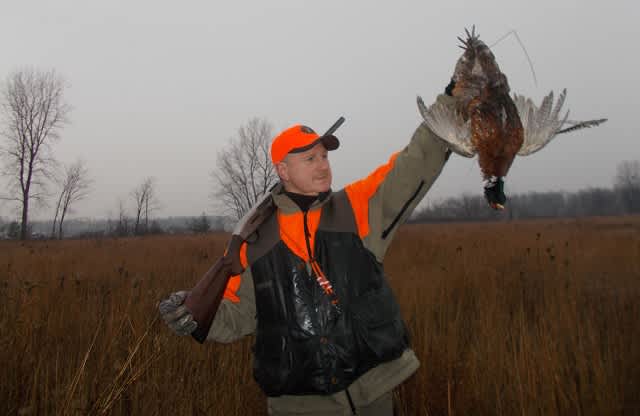Preserving Michigan Pheasant Hunting: A Long Road Ahead
Bob Gwizdz 12.28.12

Brian Gross is a lifelong pheasant hunter and the president of a county chapter of Pheasants Forever. And though he’s pleased that the Department of Natural Resources has put pheasant hunting on the front burner again, he’s not especially optimistic the state’s Pheasant Restoration Initiative will bear fruit unless something dramatic happens to the federal farm bill.
He offered to illustrate his point recently as we spent a couple of hours driving around–and bird hunting–in Shiawassee and Saginaw counties.
We hunted three little pieces of land; each was enrolled in the Conservation Resources Enhancement Program (CREP). CREP is a federal program that pays farmers to set aside erosion-prone land that adjoins waterways–rivers, creeks, drains, whatever.
It was immediately apparent to me how the program works when I saw the land: the first place we hunted was an L-shaped swatch of grass that ran along two borders of the property adjoining ditches. The grass belt was narrow, about 50 feet, which, I believe, corresponds to the dimension that the feds subsidize.
Or first short hunt–20 minutes or so–was relatively uneventful. Ruby, Gross’s young Brittany, worked hard and thoroughly, but the only birds were flushed were hens. As we made our way to toward the far end of ascending portion of the L, I noticed birds bailing out well in front of us (which is not all that unusual by mid-December).
At our next stop, we put Rub, my setter, down on a U-shaped belt of grass (ditches along the roads with one of them intersecting the county drain on the back side of the property). Just a few minutes into it the second leg of the course, I saw Rub frozen on point back toward me. I walked directly at him. The bird flushed. I dispatched a load of No. 5s and dropped him. It was the first rooster that I shot over Rub this year.
Our third piece of property was similar to the last: a U-shaped tract of set-aside along a pair of roadside ditches and a county drain. Ruby pointed a pair of hens along the front side, then pointed a rooster on the second leg that Gross killed.
We called it a morning at that point; we’d both killed a bird and Gross said birds are so few and far between this year he didn’t want to beat up on them anymore. I appreciate his position.

The 2012 pheasant season, Gross said, was one of his slowest ever.
“It was substantially slower than in the past,” he said. “I think I enjoyed hunting more this year than I have in the recent past because I started a young dog and I’ve had a good time doing that. So it was an enjoyable season. But numbers-wise, it was probably the worst season I’ve had in 10 or 15 years–maybe even longer. Probably longer.”
Gross, who says he’s always hunted virtually every day of pheasant season in the past, said he skipped some days this year because the farmers had either put set-aside acres back into production or mowed the grass down to nothing.
Gross guesses he’s lost six farms already and expects to lose more as set-aside contracts expire.
“I hate to be negative, but I think we’re in trouble,” he said. “With the crop prices the way they are now, the famers aren’t going to leave the land in grass unless they’re every wealthy and are thinking about conservation. Within the next four years I think almost every farm that I hunt on is going to be out of the program. I’m going to be out of business.
“If we lose this–and I think l we’re going to–we’re going to lose the biggest share of our pheasant land. I don’t see where the birds are going to survive. They’ve got to have cover and I just don’t see where it is.”
Most distressing, Gross said, is that crop insurance provisions in the new farm bill take so much of the risk out of planting marginal habitat that he thinks even some land that hasn’t been planted in recent years–but wasn’t enrolled on set-aside programs–will be planted again.
Federal farm policy has always been a big player in pheasant hunting. Though some of graybeards remember, fondly, when the small family farm had some land that wasn’t planted for the cows to graze, the truth is that the glory days of pheasant hunting in Michigan–the ‘50s and ‘60s–corresponded to the peak of the federal Soil Bank program, which paid farmers to idle land for 10 years. Fact is, today’s federal set-aside programs were patterned after the old Soil Bank days.
Gross says he won’t stop bird hunting, but he says he may be spending more time chasing grouse than pheasants in the future.
“I enjoy the hunt more than the kill,” he said. “I enjoy watching the dog work. But you have to put it all together some times. We’ve got the shooting preserves, but it’s not the same.
“The true bird hunter is going to be there and do what he can to enjoy the sport. He’ll scratch out some hunting. But unless something changes, we’re going to lose more small game hunters.”

